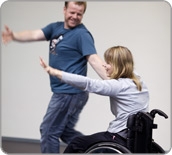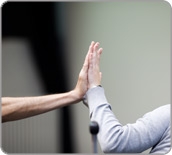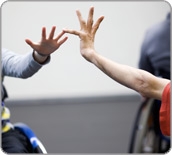




tanzfähig
Initiative for greater diversity in dance
The tanzfähig initiative aims to add the dimension of physical diversity tocontemporary dance, and is educationally as well as artistically oriented.
Developed from a melting pot of ideas in the disciplines of contemporary dance
and dance improvisation, tanzfähig strives to provide access to dance for all people,
and to support physical diversity among dancers.
tanzfähig was conceived by Bernhard Richarz in 2006 and was further developed
in collaboration with Kolja Seifert between 2007 and 2009. Evelyne Wohlfarter and
Bernhard Richarz have been working on tanzfähig since May 2010.
This present collaboration has taken the initiative to where it is today.
Dancing the embodied
Both biography and culture inscribe themselves onto the body. Both mould and containthe body's shapes and movements. When the dancer's presence can be seen in their
perception, sensations, and experience, the dance transcends itself beyond appearances.
tanzfähig believes that every body is able to dance. The dance follows where the body leads.
All bodies meet many chances and many borders; the possibilities and limitations are equal.
Meeting the diverse
Both curiosity towards the other and a sense of safety in ourselves are needed in orderto allow differences to co-exist. When a dance is open to the other's unknown and
strange corporeality, as well as to the unexpected in our own body, then things can get exciting!
The fundamental principle of the tanzfähig initiative is to support the diversity of people
in experience, origin, age, and (dis)ability. At the same time, in dancing together the effects
of those parameters are transformed.
Creating the aesthetic
Beyond presenting only what is socially acceptable, it is necessary to honor and developthe socially unacceptable, and to present it in a coherent form. Dance becomes significant
artistically when it faces contradictions.
The initiative tanzfähig advocates for plurality in dance and resists all uniformity. In dancing
together, we support and represent a high level of diversity, while acknowledging that
sometimes exclusions cannot be avoided.